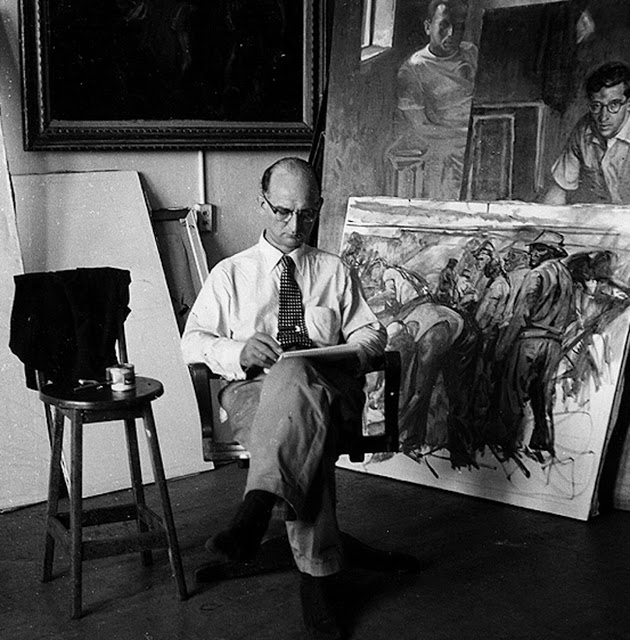Contributed by Jonathan Stevenson / Bridge of Spies begins and ends with a painting. Steven Spielberg�s latest film is a penetrating and affecting consideration of the Cold War, based on a celebrated real-life spy swap between the United States and the Soviet Union. The painter in question is Rudolf Abel (brilliantly played by Mark Rylance with wry, mournful soul), first seen serenely composing a self-portrait in his Brooklyn apartment in 1957, at the height of Cold War dread and paranoia.
[Image at top: An image of Abel’s actual apartment at 252 Fulton Street in DUMBO. When journalists were granted access in 1957, the small studio contained some of Abel’s paintings, as well as his spying materials. Image by an unnamed photographer working for Wide World Photos. Image via Awesome Stories]
His vocation is KGB covert intelligence officer, and he collects American secrets and passes them to his Soviet handlers in hollow nickels, painting en plein air as cover for dead drops. After the FBI catches him, the Justice Department assigns as Abel�s defense lawyer the reputable Brooklyn litigator and former Nuremburg prosecutor James Donovan (Tom Hanks in James Stewart mode, never better). The idea is to provide a semblance of due process to uphold America�s image of liberal rectitude on the way to Abel�s inevitable execution. But for Spielberg decency always trumps ideology. Donovan takes his job as an advocate far more seriously and does it far better than the CIA and most other Americans, some of whom threaten and harass him, hoped he would. Abel is spared the death penalty, and put to use as trade bait for U-2 pilot Francis Gary Powers, who is shot down by Soviet surface-to-air missiles while taking photographs of Soviet military installations from 70,000 feet. Negotiated by Donovan, the exchange occurs, as it did in the actual event, in February 1962 on Berlin�s Glienicke Bridge � the Bridge of Spies.
In the film, Abel�s art is the emblem of his humanity. Donovan understands theoretically that “every person matters.” But Abel’s importunate request for drawing materials while incarcerated, amplified by his otherwise stoic fa�ade, is Donovan�s real moment of recognition. He then sees that he may be defending an incongruously estimable man, and it triggers a new zealousness in his professional endeavor. Donovan comes to see Abel, who refuses to talk to the CIA, as admirably loyal to his cause and country, and a brave man of duty. Abel sizes up Donovan similarly. The two men tacitly become friends. On the Bridge of Spies, Donovan holds up the swap pending the East Germans� fulfillment of their collateral promise to release American graduate student Frederic Pryor, who has been spuriously detained in East Berlin. Abel heeds Donovan, ignoring a CIA functionary�s command, and stays put until Pryor is freed. As Abel proceeds, he tells Donovan he earlier sent the lawyer a gift � a painting, which turns out to be a portrait of Donovan in the courtroom. So Abel has left no doubt that Donovan will have the painting regardless of what happens on the bridge. (Interestingly, Donovan would later become president of Pratt.)
Metaphorically, Spielberg suggests that art connects people more strongly than ideology separates them. Other fine movies � recently, for instance, von Dannersmarck�s The Lives of Others (2006) � also get at this point. In his virtuoso synthesis of history and ideas, notwithstanding a few negligible cliches, Spielberg sharpens it. Ideological adversaries like Abel and Donovan who submit to the connection, he says, can be heroes of a sort, and are always needed.
——
Two Coats of Paint is licensed under a Creative Commons Attribution – Noncommercial-No Derivative Works 3.0 United States License. To use content beyond the scope of this license, permission is required.



















did Rudolph Abel paint James Donovan’s portrait in real life and where is it now ???? Thank you
i wondered the same thing?
Obviously the painting shown in Spielberg’s movie ” Bridge of Spies”, painted by Able of Donovan was just the Directors idea to solidify the friendship between these two men.
Who painted the portrait of Tom Hanks? I thought it was very good.
Pingback: Why was abel painting a portrait of himself? - 2 Paintings
Who painted the canvas of Tom Hanks?
Where is the painting of james p donovan painted by rudolph abel? I would be I interested in buying it!!
Even though Rudolf Abel was a better Cold War Spy for the Soviet Union than an actual painter, his role in the history of the two nations makes him famous. It’s for that reason that some of Abel’s paintings (that survive) should become posters. I think they would be in demand by a select group of people who are interested in real history.